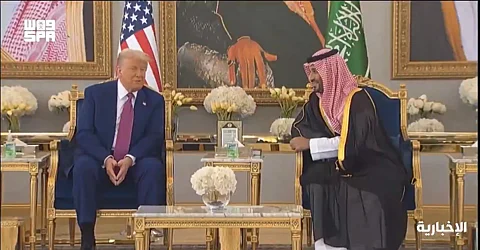

President Donald Trump launched a four-day Middle East tour on Tuesday, arriving in Saudi Arabia to a lavish reception from Crown Prince Mohammed bin Salman, the kingdom’s de facto ruler.
The visit, Trump’s first major international trip of his second term, aims to secure significant business agreements, advance U.S. interests in energy and artificial intelligence, and navigate complex regional dynamics.
Trump was greeted with pomp at King Khalid International Airport, where Royal Saudi Air Force F-15s escorted Air Force One.
Crown Prince Mohammed welcomed the president on a lavender carpet at the Royal Terminal, leading to a grand hall where attendants in ceremonial attire served Arabic coffee.
The leaders later joined a lunch at the Royal Court, surrounded by ornate decor and attended by prominent U.S. business executives, including Tesla CEO Elon Musk, Blackstone’s Stephen Schwarzman, and BlackRock’s Larry Fink.
“When Saudis and Americans join forces, very good things happen — more often than not, great things happen,” said Saudi Investment Minister Khalid al-Falih, highlighting the potential for collaboration.
Trump’s agenda includes a U.S.-Saudi investment conference and a formal dinner hosted by the crown prince, with discussions focusing on dismantling Iran’s nuclear program, stabilizing oil prices, and ending the Gaza conflict.
Saudi Arabia, a leading OPEC+ member, has increased oil production to align with Trump’s push for lower energy costs, a strategy he links to curbing U.S. inflation and pressuring Russia in its war with Ukraine.
However, with Brent crude at $64.77 per barrel and Saudi Arabia needing $96-$98 to balance its budget, sustaining high production poses challenges.
“One of the challenges for the Gulf states of lower oil prices is it doesn’t necessarily imperil economic diversification programs, but it certainly makes them harder,” noted Jon Alterman, a Middle East analyst at the Center for Strategic and International Studies.
Trump’s itinerary, including stops in Qatar and the UAE, targets deals exceeding $1 trillion, spanning AI, energy, and arms sales.
The presence of executives like Nvidia’s Jensen Huang and Amazon’s Andy Jassy underscores Saudi Arabia’s ambition to diversify its oil-dependent economy through technology investments.
Notably, Trump’s tour omits Israel, a decision that has raised eyebrows.
“The main message coming out of this, at least as the itinerary stands today, is that the governments of the Gulf ... are in fact stronger friends to President Trump than the current government of Israel at this moment,” said William Wechsler of the Atlantic Council.
Tensions with Israel stem from Trump’s unannounced halt to U.S. airstrikes against Yemen’s Houthis and undisclosed talks with Hamas and Iran.
“Israel will defend itself by itself,” Israeli Prime Minister Benjamin Netanyahu declared last week. “If others join us — our American friends — all the better.”
Trump also aims to revive his Abraham Accords initiative to normalize Saudi-Israeli ties, but Riyadh demands U.S. security guarantees, nuclear assistance, and progress on Palestinian statehood.
Crown Prince Mohammed’s recent hosting of Palestinian Vice President Hussein Sheikh signals Saudi Arabia’s insistence on addressing Palestinian concerns, with analyst Hussain Abdul-Hussain noting, “Knowing how the Saudis telegraph their intentions, that’s a preemptive, ‘Don’t even think of asking us to show any goodwill toward normalization.’”
As Trump navigates the Gulf’s wealth and geopolitical complexities, his transactional approach faces scrutiny.
The tour, shadowed by his family’s business interests in the region, including real estate projects in Jeddah, Dubai, and Qatar, underscores the delicate balance between diplomacy and personal gain.
With potential stops in Istanbul for Russia-Ukraine peace talks, Trump’s trip signals an ambitious, high-stakes bid to reshape U.S. influence in the Middle East.